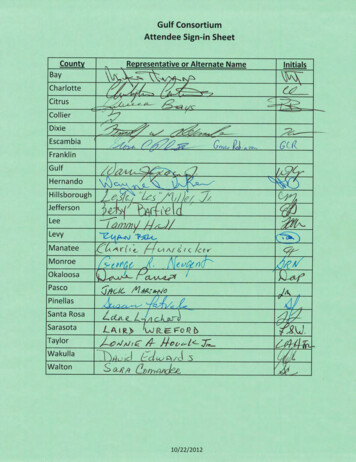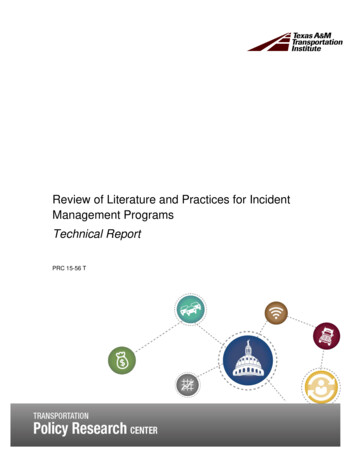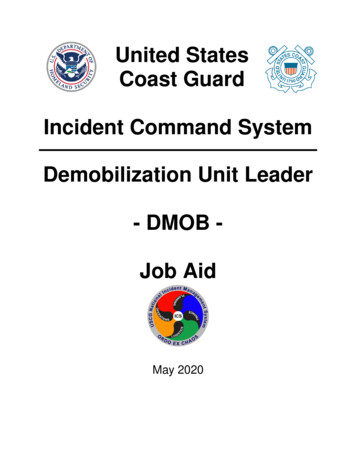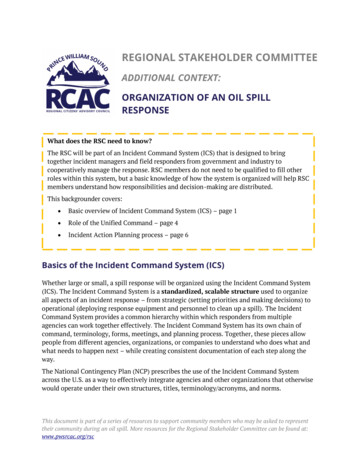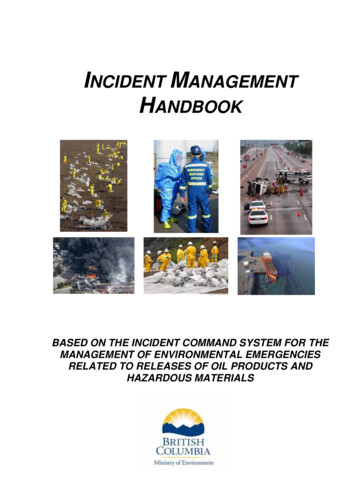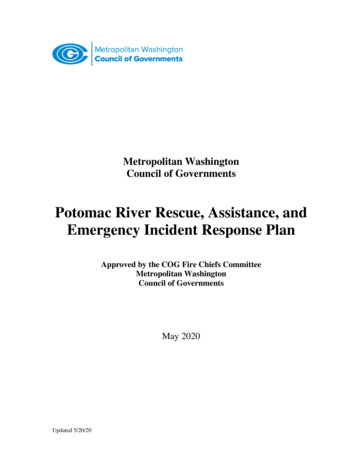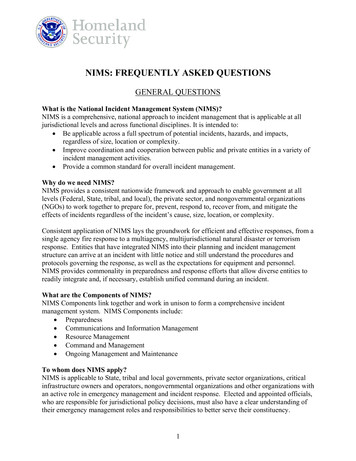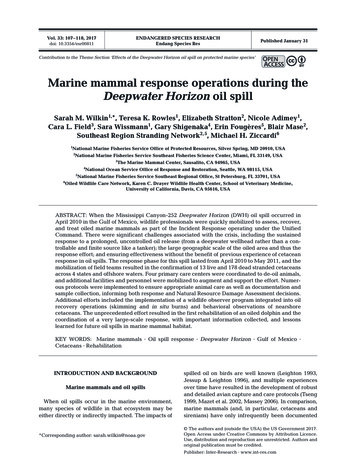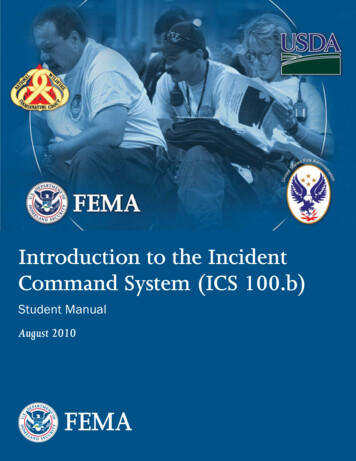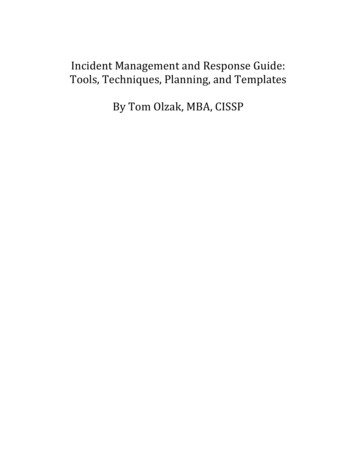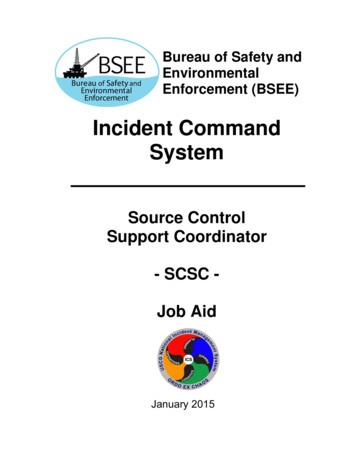
Transcription
Bureau of Safety andEnvironmentalEnforcement (BSEE)Incident CommandSystemSource ControlSupport Coordinator- SCSC Job AidJanuary 2015
BSEE SCSC Job AidCommon Incident Command System (ICS)OrganizationIncident Command/Unified CommandSource ControlSupport CoordinatorScientific SupportCoordinatorPublic SourceControlBranchDirectorFigure 1 Common ICS Organization with Source ControlPersonnel may be moved from their initial placementFigure2 CommonOrganization withto the needsof an evolving incident. Be flexible.ii
BSEE SCSC Job AidSample Source Control Organization within ICSA source control organization could vary dependingon the incident needs. The dashed lines between theOperations Section Chief, Source Control BranchDirector, and Source Control Support Coordinatorrepresent ongoing technical source controlcommunications.Incident Command/Unified CommandSource ControlSupport CoordinatorOperations SectionChiefSource ControlBranch visorFigure 3 SampleFigure 2 Sample Source Control Organizationiii
BSEE SCSC Job AidThis page intentionally left blank.iv
BSEE SCSC Job AidTable of Contents1.0 Source Control Support CoordinatorOverview . 11.1 User . 11.2 When to Use . 31.3 How to Use . 41.4 Major Tasks for the Source ControlSupport Coordinator Position . 71.5 References . 81.6 ICS Forms . 92.0 Checklists . 102.1. Ready for Deployment . 102.1.1 Pre-Incident Actions (IndividualReadiness) . 102.1.2 Deployment Preparations . 102.2 Ready for Operations . 112.2.1 Check In to the Incident. 112.2.2 Obtain Situational Awareness . 112.2.3 Initial FOSC Meeting . 122.3 Initial Response & Assessment . 132.3.1 Initial Incident Brief . 142.3.2 Initial Unified Command Meeting . 142.4 Manage People and the Source ControlOrganization . 152.4.1 Activate SCSC Support Personnel . 15v
BSEE SCSC Job Aid2.4.2 Establish/assess source controlorganization and communication practices152.5 Oversee Source Control Operations . 162.5.1 Execute Source Control and IncidentAction Plans and Assess Progress . 162.5.2 Consult with Partners/Stakeholders. 172.5.3 Seek consensus among partners andstakeholders . 182.6. Support the Operational PlanningProcess. 192.6.1 Prepare for UC Objectives Meeting . 192.6.2 UC Objectives Meeting . 192.6.3 Command and General Staff Meeting . 202.6.4 Prepare for the Tactics Meeting. 202.6.5 Tactics Meeting . 202.6.6 Prepare for the Planning Meeting . 212.6.7 Planning Meeting . 212.6.8 Preparation and Approval of IAP . 222.6.9 Operations Briefing . 222.7 Transition and Demobilization . 232.7.1 Transition to On-Going OperationsPhase . 232.7.2 Complete relief process . 242.7.3 Demobilization . 24vi
BSEE SCSC Job Aid2.7.4 Complete Return Travel . 253.0 Detailed Instructions for ChecklistItems . 263.1. Ready for Deployment . 263.1.1 Pre-Incident Actions (IndividualReadiness) . 263.1.2 Deployment Preparations . 273.2. Ready for Operations . 283.2.1 Check in to the Incident . 283.2.2 Obtain Situational Awareness . 303.2.3 Initial FOSC Meeting . 323.3 Initial Response and Assessment . 333.3.1 Initial Incident Brief . 353.3.2 Initial Unified Command Meeting . 363.4 Manage People and the Source ControlOrganization . 373.4.1 Activate/Assess SCSC SupportPersonnel . 373.4.2 Establish Source Control Organizationand Communication Practices . 383.5 Oversee Source Control Operations . 393.5.1 Execute Source Control and IncidentAction Plans and Assess Progress . 393.5.2 Consult with partners/stakeholders . 41vii
BSEE SCSC Job Aid3.5.3 Seek consensus amongpartners/stakeholders . 433.6 Support the Operational PlanningProcess. 443.6.1 Prepare for UC Objectives Meeting . 443.6.2 UC Objectives Meeting . 443.6.3 Command and General Staff Meeting . 453.6.4 Prepare for the Tactics Meeting. 463.6.5 Tactics Meeting . 483.6.6 Prepare for the Planning Meeting . 493.6.7 Planning Meeting . 503.6.8 IAP Preparation and Approval . 513.6.9 Operations Briefing . 513.7 Transition and Demobilization . 523.7.1 Transition to On-Going OperationsPhase . 523.7.2 Complete Relief Process . 533.7.3 Demobilization . 543.7.4 Complete Return Travel . 54viii
BSEE SCSC Job Aid4.0 Appendices . 554.1 Functional Interactions . 554.2 ICS Map/Chart Display Symbology . 614.3 Sample Well Containment Activities . 624.4 Acronym List . 654.5 Glossary . 70Table of FiguresFigure 1 Common ICS Organization . iiFigure 2 Sample Source Control Organization . iiiFigure 3 Organization and Flow of Checklist Items .5Figure 4 ICS Operational Planning "P" Process .6ix
BSEE SCSC Job Aid11.0 Source Control Support CoordinatorOverview1.1 UserThe user of this job aid will be anyone assigned as aSource Control Support Coordinator (SCSC) withinthe National Incident Management System (NIMS)Incident Command System (ICS).The SCSC is the principal advisor to the FOSC forsource control issues and a member of the commandstaff. The SCSC is a Technical Specialist (THSP)responsible for providing source control support foroperational decisions and for providing oversight ofsource control efforts during an event involving theloss of well control on the Outer Continental Shelf.Personnel assigned to this position should have anextensive source control technical and operationalbackground, as well as a leadership background andexperience working with people in otherorganizations or agencies. BSEE has finalresponsibility for monitoring and directing all effortsrelated to securing the source of a discharge andreestablishing source control.This job aid assumes the SCSC has a workingknowledge of the ICS, fundamental skills in UnifiedCommand, and extensive source controlqualifications and experience.
BSEE SCSC Job Aid2This job aid does not cover other important traits ofan effective SCSC, such as: Effective communication skills Professional demeanor in contentious situations Experience in resolving issues or conflicts A solid grasp of public affairs and governmentalaffairs, organizational goals, objectives, andmissions Experience in risk-based decision making A solid grasp of political, social, environmental,and economic issues Adaptability and flexibility to the needs of theincident An in-depth knowledge of substantive aspectsof the incident at hand Excellent situational awareness to be able toquickly develop a perspective on the scope,scale, and long-term consequences of theresponse Ability to facilitate organizational success interms of developing processes that bringtogether participating organizations andstakeholders to meet shared goals andobjectives as the response effort evolvesA high-performing SCSC exhibits these traits andmany more in addition to properly executing the ICS.
BSEE SCSC Job Aid31.2 When to UseThis job aid focuses on the role of the Source ControlSupport Coordinator in executing duties under theIncident Command System (ICS) to ensure effectivecoordination throughout the Incident ManagementTeam (IMT) during a response to an incidentrequiring source control. The job aid should be usedto assist the SCSC whenever an incident hasoccurred or during training or a planned drill orexercise that requires an Incident Command Systemorganization. Use it as a supplement to the U.S.Coast Guard Incident Management Handbook (IMH).
BSEE SCSC Job Aid41.3 How to UseThis job aid will help the user integrate source controlinto an ICS organization and effectively engage withthe Incident Management Team (IMT). This job aidwill provide the user with a perspective on howsource control fits into the larger ICS organization,what the SCSC will be expected to provide, and howto be optimally prepared for and support the ICSoperational planning process.This job aid is comprised of the following sections: Checklists Ready for Deployment: Individual Readiness Initial Response & Assessment Ready for Operations: Actions completedupon activation that enable you to beginyour assigned duties Manage People and the Source ControlOrganization: Set up and maintenance ofthe source control organization Oversee Source Control Operations Support Operational Planning: Guidance forintegrating source control activities into theICS Operational Planning “P" sequence Transition and Demobilization Detailed Guidance for Checklist Items Supporting detail for each of the ChecklistCategories Above Appendices
BSEE SCSC Job Aid5ManagePeopleInitialResponse nSupportOperationalPlanningFigure 3 Organization and Flow of Checklist ItemsThe checklists present steps in the most probablesequence, but in practice the user may referencemultiple checklists simultaneously. Additionally,where you enter the incident evolution will determinewhich steps are required of you; for example, first-onscene personnel must perform different tasks thanpersonnel arriving after an initial response.Supporting detail for the checklist items can be foundin the Detailed Guidance for Checklist Items section.Use the checklists to plan and track your actions;refer to the supporting detail section for explanationsand additional information.
BSEE SCSC Job Aid6The initial actions to an incident are taken rapidly anda situational summary is generated quickly thereafterwhich is usually referred to as an initial “201 incidentbrief”. This brief serves as the initial incident actionplan (IAP) until a more comprehensive document canbe developed for the next operational period.Following the 201 brief, simultaneous activities occurto manage operations while planning for the nextoperational period through a process known as theICS operational planning cycle. For more detailedguidance on the ICS operational planning cycle, referto Chapter Three of the USCG IMH.Figure 4 ICS Operational Planning "P" Process
BSEE SCSC Job Aid71.4 Major Tasks for the Source Control SupportCoordinator Position SCSC is deployment readySCSC is ready for operational taskingSCSC is ready for operation executionSCSC functions are complete Advise the FOSC on all source controlactivity Provide official government well interventionexpertise, engineering support andinspection resources Provide worst case discharge forecastingand flow rate modeling Provide source control analysis foroperational decisions Approve source control contribution toIncident Action Plan (IAP) Oversee source control activity Engage partners and stakeholders andintegrate knowledge in evaluating hazards,strategies, and outcomes for source controlactivities Advise the PIO on source control informationand messaging Provide information to BSEE leadership SCSC is demobilizedInformation on the SCSC role and commonresponsibilities can also be found on page 20-8 ofthe USCG IMH.
BSEE SCSC Job Aid81.5 ReferencesBelow is a list of references that may be requiredwhile using this job aid: USCG Incident Management Handbook (IMH)COMDTPUB P3120.17 is the key reference forexecuting Incident Command System processes.The IMH is available on the Coast Guard ICSwebsite at http://homeport.uscg.mil/ics/. Helix Well Containment Group IMH for DeepwaterWell Control Operations BSEE/USCG MOA: OCS-03, April 3, 2012
BSEE SCSC Job Aid1.6 ICS FormsICS Forms can be found on the Coast Guard ICSwebsite at http://homeport.uscg.mil/ics/.Generally, the SCSC will have some level ofresponsibility for information on the following formsthat may be found within NIMS ICS incidentmanagement software: Incident Briefing (ICS 201) Incident Objectives (ICS 202) Organization Assignment List (ICS 203) Assignment List (ICS 204) Assignment List Attachment (ICS 204a) Communications List (ICS 205a) Incident Organization Chart (ICS 207) Site Safety Plan (ICS 208) Incident Summary Status (ICS 209) Check-In List (ICS 211) General Message (ICS 213) Resource Request Message (ICS 213RR) Activity Log (ICS 214) Incident Action Plan Safety Analysis (ICS 215a) Demobilization Check-Out (ICS 221) Incident Personnel Performance Rating (ICS225) Daily Meeting Schedule (ICS 230) Incident Open Action Tracker (ICS 233) Work Analysis Tracking (ICS 234) Incident Mishap Reporting Record (ICS 237)9
BSEE SCSC Job Aid102.0 Checklists2.1. Ready for Deployment2.1.1 Pre-Incident Actions (Individual Readiness) Assemble position deployment kit.(See detail on page 26) Validate personal readiness.(See detail on page 26-27) Validate SCSC training/certifications.(See detail on page 27)2.1.2 Deployment Preparations Receive assignment. Verify reporting location, date, and time.(See detail on page 27) Finalize personal readiness for assignment.(See detail on page 27) Verify/update position deployment kit.(See detail on page 28) Arrange/verify berthing/lodging/transportation. Complete agency/company deploymentrequirements. Make travel arrangements.
BSEE SCSC Job Aid112.2 Ready for Operations2.2.1 Check In to the Incident Check-in on the ICS Form 211.(see detail on page 28) Check in with the Resource Unit forassignment. (see detail on page 28) Check in with Finance and Logistics.(see detail on page 28) Review and sign ICS Form 208, Site SafetyPlan. (see detail on page 29)2.2.2 Obtain Situational Awareness Review ICS Form 201, Incident Briefing ORthe Incident Action Plan (IAP).(see detail on page 30) Review key incident information.(see detail on page 30) Identify resources on scene.(see detail on page 31) Review the size and complexity of the incident.(see detail on page 31) Identify special considerations for the incident.(see detail on page 31) Review the applicable sections of theContingency Plan(s). Review the Common Operational Picture(COP). Obtain a meeting and briefing schedule.(see detail on page 31)
BSEE SCSC Job Aid122.2.3 Initial FOSC Meeting Meet with Federal On-Scene Commander(FOSC)(see detail on page 32) Discuss IC/UC expectations for source control Define your role as SCSC.
BSEE SCSC Job Aid2.3 Initial Response & Assessment Identify incident objectives.(see detail on page 33) Identify incident strategies and tactics.(see detail on page 33) Identify incident priorities.(see detail on page 33) Assess incident reporting and meetingcycle. (see detail on page 33) Consult well-specific documents. Consult with source control personnel, ifactivated. Conduct a resource needs analysis.(see detail on page 33) Request resources using ICS Form 213RR.(see detail on page 33) Identify deputies, as needed. Establish effective communications.(see detail on page 33-34)13
BSEE SCSC Job Aid142.3.1 Initial Incident Brief Receive brief from Federal On-SceneCommander (FOSC)(see detail on page 35) Obtain IC/UC expectations Assist in the ICS-201 Brief, if needed.(see detail on page 35) On-coming SCSC meets with relievedSCSC, if applicable. (see detail on page 35) Determine the size and complexity of incident. Determine limitations and constraints.(see detail on page 35) Explain your role as SCSC.(see detail on page 35)2.3.2 Initial Unified Command Meeting Identify agencies and organizations that needto be represented in the UC.(see detail on page 36) Identify assisting and coordinating agenciesand organizations. (see detail on page 36) Clarify SCSC role and responsibilities.
BSEE SCSC Job Aid152.4 Manage People and the Source ControlOrganization2.4.1 Activate SCSC Support Personnel Determine/assess staffing requirements (e.g.,deputies or inspectors needed).(see detail on page 37) Request resources using ICS Form 213RR.(see detail on page 37) Appoint deputies, as needed.(see detail on page 37)2.4.2 Establish/assess source controlorganization and communication practices Assist the Federal On Scene Commander(FOSC) in determining source controlorganization. (see detail on page 38) Communicate source control priorities andobjectives. (see detail on page 38) Define SCSC communication expectations.(see detail on page 38) Confirm effective communications.(see detail on page 38) Establish use of common terminology.(see detail on page 38) Ensure the source control picture is fed to theCommon Operational Picture (COP).
BSEE SCSC Job Aid162.5 Oversee Source Control Operations2.5.1 Execute Source Control and Incident ActionPlans and Assess Progress Provide well intervention expertise.(see detail on page 39) Monitor source control efforts.(see detail on page 39) Evaluate source control efforts.(see detail on page 39) Monitor multiple options under development.(see detail on page 39) Revise efforts as required.(see detail on page 39-40) Monitor flow rate modeling.(see detail on page 40) Advocate for the Source Control BranchDirector (SCBD), when necessary.(see detail on page 40) Monitor the approval process for subseadispersant use. Consider activating specialty tools andgroups. Authorize release of source control relatedinformation. (see detail on page 40) Ensure safety is a top priority.(see detail on page 39) Conduct regular Agency briefings forexecutive leadership.(see detail on page 37)
BSEE SCSC Job Aid2.5.2 Consult with Partners/Stakeholders Delegate tasks to deputies, as needed.(see detail on page 41) Attend required meetings. Assess depth of knowledge ofpartners/stakeholders.(see detail on page 41) Assess quality of relationships betweenpartners/stakeholders. (see detail on page 42) Ensure partners/stakeholders use commonterminology. Receive input from partners/stakeholders.(see detail on page 42) Ensure a recorder is present to recordpartner/stakeholder concerns/needs. Document decisions.(see detail on page 42)17
BSEE SCSC Job Aid182.5.3 Seek consensus among partners andstakeholders Integrate collective knowledge.(see detail on page 43) Identify competing interests amongpartners/stakeholders. Prioritize issues.(see detail on page 43) Promote unity of effort. Increase inter- / intra-agency coordination,when necessary. (see detail on page 43) Reduce conflict among partners/stakeholderson source control issues.
BSEE SCSC Job Aid2.6. Support the Operational Planning Process2.6.1 Prepare for UC Objectives Meeting Prepare source control objectives.(see detail on page 44) Identify limitations and constraints.(see detail on page 44)2.6.2 UC Objectives Meeting Provide source control objectives.(see detail on page 44) Advise FOSC in establishing source controlpriorities.19
BSEE SCSC Job Aid202.6.3 Command and General Staff Meeting Attend Command and General Staff meeting.(see detail on page 45) Receive IC/UC direction(see detail on page 45) Provide source control status brief.(see detail on page 45) Provide feedback to IC/UC on focus/direction.(see detail on page 46) Discuss source control issues and needs.(see detail on page 46) Clarify SCSC authority.(see detail on page 46)2.6.4 Prepare for the Tactics Meeting Identify current operations.(see detail on page 46-47) Consult with Source Control Branch Director(SCBD). (see detail on page 47)2.6.5 Tactics Meeting Consider an ICS facilitator or coach.(see detail on page 48) Oversee source control planning.(see detail on page 48)
BSEE SCSC Job Aid212.6.6 Prepare for the Planning Meeting Review documents from the Tactics Meeting.(see detail on page 49) Consult with Source Control Branch Director(SCBD) and Operations Section Chief (OSC).(see detail on page 49)2.6.7 Planning Meeting Consider an ICS facilitator or coach.(see detail on page 50) Oversee source control planning.(see detail on page 50)
BSEE SCSC Job Aid222.6.8 Preparation and Approval of IAP Review and verify source control relatedinformation in the IAP. Verify proper distribution of IAP to all necessaryelements of the source control organization.2.6.9 Operations Briefing Provide information as required on source controlobjectives, actions, and resource assignments inthe IAP for the upcoming operational period tooncoming supervisors Prepare for shift change (see checklists 2.7.1 or2.7.2)
BSEE SCSC Job Aid232.7 Transition and Demobilization2.7.1 Transition to On-Going Operations Phase Ensure continuity of authority and knowledge.(see detail on page 52) Ensure continued effective management.(see detail on page 52) Establish a personnel rotation.(see detail on page 52) Prioritize issues.(see detail on page 52) Ensure information is exchanged viaprescribed reporting chains.(see detail on page 52) Support operational planning process andmanage current operations simultaneously. Monitor organization for span of control.(see detail on page 52) Maintain Unit Activity Log, ICS Form 214(see detail on page 53)
BSEE SCSC Job Aid242.7.2 Complete relief process Advise relief of any change in conditions. Ensure accountability for property. Complete documentation and turn in toDocumentation Unit. Debrief SCBD and FOSC. Provide input for plan improvement.2.7.3 Demobilization Provide input to Demobilization Plan. Confirm demobilization instructions with FOSC. Attend to supplies and equipment.(see detail on page 54) Supervise demobilization of SCSC supportpersonnel. (see detail on page 54) Complete ICS Form 214, After Action Report. Complete ICS Form 221, Demobilization CheckOut. Provide documentation to Documentation Unit. Inform FOSC of departure plans.
BSEE SCSC Job Aid2.7.4 Complete Return Travel Depart incident. Conduct travel in accordance withDemobilization Plan.detailDemobilizationon page xx)ContactUnit Leader upon (seearrival at home location.25
BSEE SCSC Job Aid263.0 Detailed Instructions for Checklist Items3.1. Ready for Deployment3.1.1 Pre-Incident Actions (Individual Readiness)1. Assemble position deployment kit. Gather manuals, USCG IMH, ICS forms,software, and technical equipment you willneed for running the Source Control Branch. Gather appropriate Personal ProtectiveEquipment (PPE) for the SCSC position.2. Validate personal readiness. Personal readinessincludes: medical, dependent, financial, andlegal readiness. Should you deploy withoutbeing personally ready, it will affect your abilityto respond and cause a burden on the incidentmanagement team. Verify medical readiness. Ensure you do nothave outstanding issues that would preventyou from being deployed. For example,ensure you have enough medications for theentire period of the deployment. Verify emergency contact information.Ensure you provide current emergencycontact information to your agency/companysupervisor and on-site supervisor. Verify dependent care. Ensure you have aplan for dependent care/pet care for whenyou deploy. Verify financial readiness. Ensure your
BSEE SCSC Job Aid27finances are in order, includingagency/company credit card limit, plan forbills to be paid will deployed. Verify legal readiness. Ensure your legaldocuments are current and in order, includingbut not limited to your will, power(s) ofattorney, voting registration, taxrequirements, etc. Consult your legal advisorfor complete guidance.3. Validate SCSC training/certifications. EnsureSCSC required/recommended training iscurrent. Mandated training ICS training, e.g., ICS 100, 200, 300, 400,700, 800 (SCSC certification recommendations/requirements are not yet defined orestablished.)3.1.2 Deployment Preparations1. Verify reporting location, date, and time. Verify the reporting location, date, and time. Verify the check-in location. Verify the Incident Command Post (ICP)contact number for assistance with check in.2. Finalize personal readiness for assignment. Review the pre-assignment check list toensure readiness, including medical,dependent care, financial, and legalreadiness.
BSEE SCSC Job Aid283. Verify/update position deployment kit. Verify the manuals, forms, technicalequipment you will need to perform thefunctions of the SCSC. Verify appropriate Personal ProtectiveEquipment (PPE) for the SCSC position.4. Arrange/verify berthing/lodging/transportation.5. Complete agency/company deploymentrequirements.3.2. Ready for Operations3.2.1 Check in to the Incident1. Upon arriving to the incident, check in at thedesignated check-in location. Use ICS Form 211, Check-in List.2. Check in with the Resource Unit. Receive your position and shift assignmentwhich may be slightly different than when youwere called in.3. Check in with the Finance Section.4. Check in with the Logistics Section. Obtain berthing assignment, if applicable.Logistics may have contracted with a localhotel for incident personnel. Even if you havemade your own arrangements, Logisticsshould be informed where personnel areberthed. Receive meal schedule. Arrange for transportation.5. Review ICS Form 208, Site Safety Plan.
BSEE SCSC Job Aid296. Sign the worker acknowledgement form – ICS 208,Site Safety Plan. Periodically review the SiteSafety Plan to learn of any additions and updatesto the Plan.Additional Information: Check in recorders mayrequest a phone number where you can be reached,the name of the agency/company you deployed from,as well as any additional qualification you may have.Some incidents require credentials (badges) for allassigned personnel. If credentials are issued, youshould receive them upon check in.
BSEE SCSC Job Aid303.2.2 Obtain Situational AwarenessThe purpose of this task is to acquire additionalbackground on the incident prior to starting yourassignment.1. Review the current ICS Form 201, IncidentBriefing, OR the current Incident Action Plan (IAP). ICS-201 is used during initial response. The IAP is used after initial response.Consider reviewing all of the IAPs that havebeen generated for the incident.2. Review key incident information: Identify the agencies, organizations, andpersonnel that comprise the IncidentCommand/Unified Command (IC/UC). Thismay provide insight into the stakeholders andwhy the Command is setting particularobjectives, as well as media issues orconcerns. What is the well/oil? This will give you an ideaof the resources that should be operating intheatre. When did the incident occur? Assess incidentchanges over time, including survival rates,weathering of oil, potential contaminants,vessel stability, etc. Where did the incident occur? Are you familiarwith the area, the platform, any equipmentinvolved?
BSEE SCSC Job Aid313. Identify resources that are on scene and/orenroute, and estimated time of arrival.4. Review the size and complexity of the incident. Is the incident expanding or contracting? Whatis the media interest?5. Identify special considerations for the incident(e.g., political, social, environmental, threats,vulnerabilities).6. Review applicable sections of the ContingencyPlan(s).a. Well containment planb. Oil spill response plan (OSRP)c. Regional Containment Demonstration (RCD)7. Review applicable incident documentation. Review the most recent ICS Form 209,Incident Status. Evaluate incident documentation for safetyconcerns. Review maps/charts/imagery of the incident. Obtain wellbore schematic. Review the organizational chart. Identify source control sites, activities,and personnel. Identify the agencies, organizations, andpersonnel that comprise the IC/UC.8. Review the Common Operational Picture (COP).9. Obtain a meeting and briefing schedule. Obtain a copy of the meetings and briefingschedule (ICS Form 230) from the PlanningSection, if developed.
BSEE SCSC Job Aid323.2.3 Initial FOSC MeetingThe initial briefing is the opportunity for the SCSC toreceive additional details about the incidentassignment and discuss their role as the SCSC. Receive brief from FOSC. Discuss IC/UC expectations for source controloperations. Discuss the integration of source control andother response operations. Discuss the structure and placement of thesource control function within the ICSorganization.
BSEE SCSC Job Aid333.3 Initial Response and Assessme
Team (IMT) during a response to an incident requiring source control. The job aid should be used to assist the SCSC whenever an incident has occurred or during training or a planned drill or exercise that requires an Incident Command System organization. Use it as a supplement to the . U.S. Coast Guard Incident Management Handbook (IMH).
